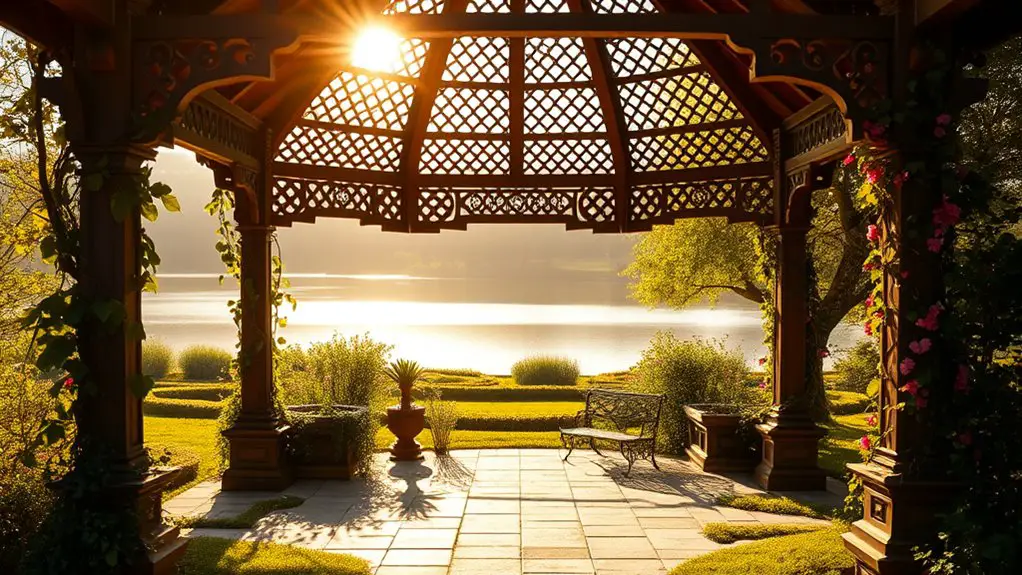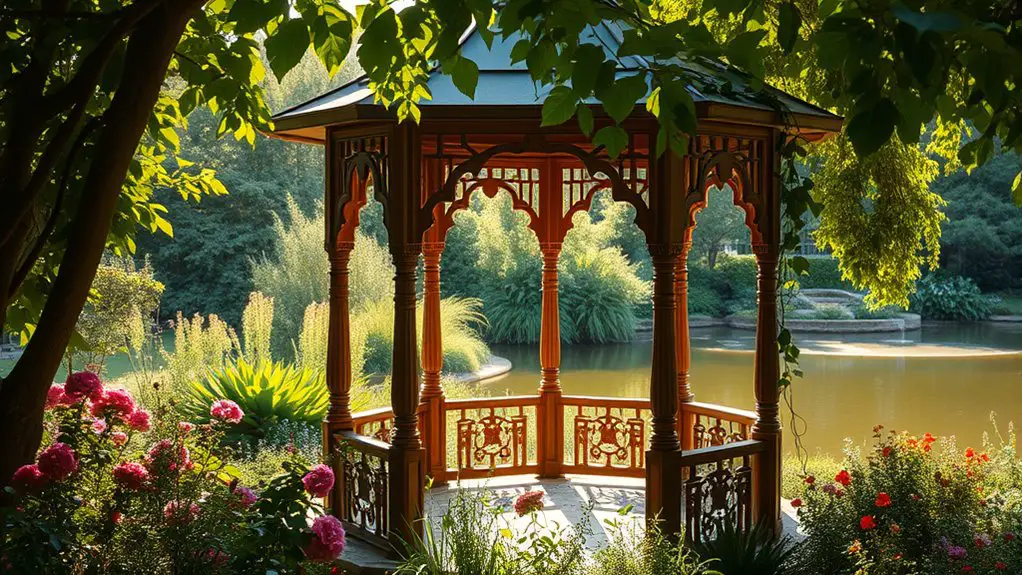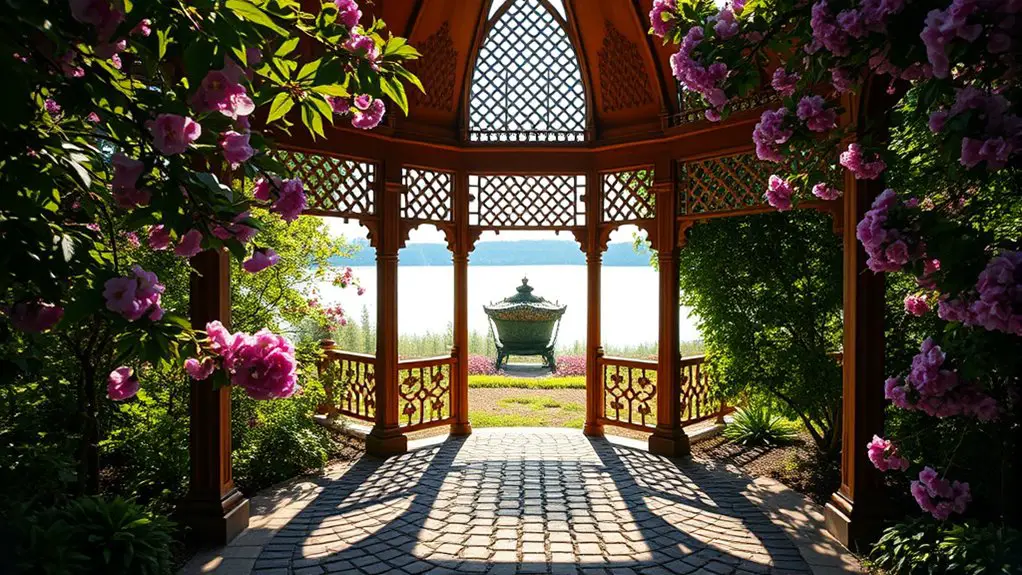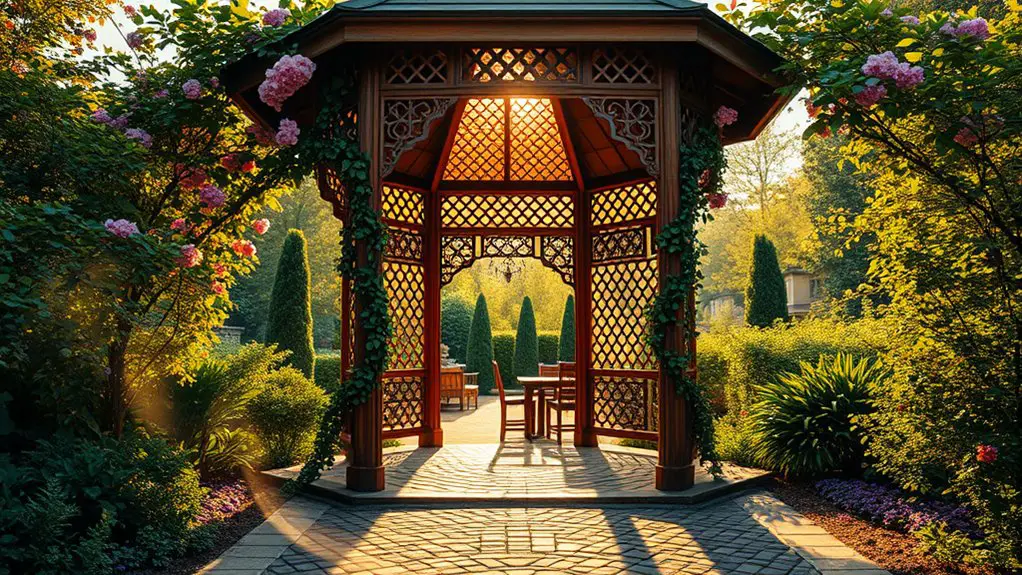Gazebos in art and literature symbolize emotional refuge and cultural connection. They act as tranquil retreats for reflection and facilitate romantic encounters while serving as community gathering points. In Romantic-era works, gazebos provide solace from societal constraints, enhancing moments of passion. Their artistic representations highlight these themes, capturing a blend of beauty and solitude. This duality invites you to explore the deeper significance they hold in various narratives and artistic expressions, revealing layers of meaning and emotion.
Historical Significance of Gazebos

Although gazebos may seem like simple garden structures today, their historical significance reveals a rich tapestry woven into the fabric of cultural and architectural evolution. You might not realize that these elegant forms have roots in various historical styles, from the ornate pavilions of the Renaissance to the minimalist structures of the 20th century. Each design reflects the values and aesthetics of its time, serving as social hubs where people gathered to enjoy nature and engage in conversation.
Their architectural significance lies not merely in their intricate designs but in their ability to transcend function, becoming a symbol of leisure and community connection. Gazebos invite you to pause, appreciate your surroundings, and embrace a moment of tranquility. By understanding their historical roots, you can better appreciate how these structures continue to inspire contemporary designs while fostering a sense of freedom in shared spaces.
Gazebos as Symbols of Nature
When you think about gazebos, you can’t help but notice how they embody a serene connection to nature. Their open structures invite you to pause and reflect on the beauty surrounding you, creating a tranquil space amidst the chaos of daily life. This symbolism enriches not only artistic representations but also literary themes, emphasizing the harmony between humanity and the natural world.
Connection to Serenity
Serenity often finds its embodiment in the delicate architecture of gazebos, which serve as tranquil retreats amidst nature’s embrace. These structures create tranquility spaces that invite you to pause, breathe, and reconnect with your surroundings. Imagine stepping into a gazebo, where the gentle rustle of leaves and the soft chirping of birds envelop you, offering a peaceful retreat from life’s chaos. Here, time seems to slow, allowing you to reflect and rejuvenate. Gazebos symbolize a harmony between built and natural environments, encouraging a deeper appreciation for the beauty around you. They remind you that within nature’s vastness, there are pockets of calm, beckoning you to explore the serenity that awaits just beyond your doorstep.
Reflection of Beauty
Gazebos stand as exquisite symbols of nature’s beauty, seamlessly blending architectural elegance with the surrounding landscape. They embody beauty ideals that resonate across cultures, inviting aesthetic appreciation through their design significance and visual harmony. When you encounter a gazebo, you experience a moment of artistic expression, where the structure enhances its natural surroundings. The emotional resonance of these spaces often evokes tranquility and reflection, offering a sanctuary amidst nature’s splendor.
| Element | Description | Symbolism |
|---|---|---|
| Structure | Open design, often adorned with art | Freedom, connection to nature |
| Material | Wood, stone, or metal | Durability, harmony |
| Location | Gardens, parks, waterfronts | Serenity, escape |
| Style | Traditional, modern, eclectic | Cultural symbolism |
| Purpose | Gathering space, solitude | Community, reflection |
The Role of Gazebos in Romantic Literature

While exploring the landscapes of Romantic literature, you’ll often encounter gazebos as more than mere architectural features; they serve as essential symbols of love, longing, and introspection. These gazebo settings create a private sanctuary, inviting characters to engage in emotional exchanges and romantic rendezvous. Within the lush, verdant surroundings, the gazebo’s structure provides shelter from societal constraints, allowing for intimate moments that reveal the depths of passion and desire.
In works by authors like Keats and Shelley, gazebos often become the backdrop for clandestine meetings, where lovers share their dreams and fears. The serene ambiance enhances the emotional weight of these encounters, symbolizing both the beauty and fragility of love. By situating pivotal scenes within these enchanting spaces, writers effectively illustrate the connection between nature, romance, and the human spirit, highlighting the transformative power of love amid the turmoil of life.
Gazebos in Poetry: A Space for Reflection
In poetry, gazebos often serve as nature’s quiet sanctuary, offering a tranquil space for introspection. When you encounter these structures in verse, they frequently symbolize solitude, inviting you to pause and reflect on your inner thoughts. This juxtaposition of built space and natural surroundings emphasizes the importance of finding peace within oneself amidst the chaos of life.
Nature’s Quiet Sanctuary
When you step into a gazebo, you often find a unique blend of solitude and nature that invites introspection, making it a perfect setting for poetry. Surrounded by the gentle rustle of leaves and the soft hum of distant birds, you’re enveloped in nature’s tranquility. This serene space becomes a canvas for your thoughts, allowing emotions to flow freely as you reflect on life’s moments. Gazebos serve as garden retreats, where the chaos of the outside world fades away. The architectural beauty, coupled with the lush scenery, inspires creativity and contemplation. Here, the stillness becomes a partner to your musings, transforming fleeting thoughts into verses. It’s a sanctuary where your spirit can roam and your imagination can soar.
Metaphor for Solitude
The gazebo’s secluded charm often transforms it into a powerful metaphor for solitude in poetry. When you step inside, you’re enveloped in a world that encourages solitary contemplation, away from the noise of everyday life. Poets often use this imagery to evoke feelings of quiet introspection, where the heart can speak freely and thoughts can roam. The gazebo stands as a physical embodiment of the desire for escape—an invitation to pause and reflect. In this sacred space, you’re given the freedom to explore your emotions, confront your thoughts, and find solace in silence. The gentle rustle of leaves and distant chirps become your companions, making the gazebo a timeless symbol of the beauty found in moments of solitude.
Artistic Representations of Gazebos

Gazebos often emerge as pivotal symbols in artistic representations, serving as tranquil retreats that invite contemplation and connection. You’ll notice how various artistic styles capture their essence, reflecting cultural influences that shape our perception of these structures. The design elements often highlight their architectural features, integrating seamlessly into landscapes while enhancing spatial dynamics. Artists employ color symbolism to evoke emotional resonance—vibrant hues can inspire joy, while muted tones may evoke nostalgia.
In historical contexts, gazebos represent societal values, embodying a longing for nature and leisure, as seen in romanticism and impressionism. Their structural aesthetics create inviting spaces, often positioned to frame breathtaking views, encouraging reflection. As you explore these artistic representations, consider how gazebos not only beautify landscapes but also serve as metaphors for the human experience, reminding us of our quest for peace amidst chaos.
Gazebos in Film and Theater
In film and theater, gazebos often serve as intimate backdrops for romantic encounters, creating a space where characters can connect away from the chaos of the outside world. These structures symbolize both an escape from reality and a threshold to new possibilities, enhancing the emotional weight of pivotal scenes. Their presence invites audiences to reflect on the nature of love and the fleeting moments that define relationships.
Romantic Encounters on Stage
While gazebos often serve as mere backdrops in film and theater, they possess a unique ability to elevate romantic encounters, transforming ordinary moments into enchanting experiences. Picture a couple, hidden from the world, sharing a romantic rendezvous under the delicate latticework of a gazebo. The structure frames their emotions, creating a sense of intimacy and seclusion. In staged encounters, the interplay of light and shadow enhances the atmosphere, making each whispered confession feel more profound. The gazebo becomes a symbol of longing, a sanctuary where love blossoms amidst the chaos of life. It invites the audience to witness a deeper connection, emphasizing the beauty of vulnerability and the magic that can unfold in seemingly simple moments.
Symbol of Escape
When characters find themselves at a crossroads, gazebos often emerge as powerful symbols of escape in film and theater. These structures offer a much-needed shelter from reality, inviting characters—and you—into a world where they can momentarily retreat from chaos. Within the serene confines of a gazebo, characters often weigh their choices, contemplate their desires, and seek solace from external pressures. This space embodies freedom, allowing them to shed societal expectations and explore their innermost thoughts. In various productions, the gazebo symbolizes not just physical separation but also emotional liberation, serving as a catalyst for transformation. Ultimately, gazebos remind us that sometimes, stepping away from the storm is essential for finding clarity and reclaiming one’s path.
Cultural Interpretations of Gazebos
Although gazebos often evoke a sense of tranquility and leisure, their cultural interpretations reveal a deeper complexity that varies across different societies. In various historical contexts, these structures serve not just as ornamental features but as essential public spaces for social gatherings. You’ll find that architectural styles and design elements differ widely, reflecting regional variations and the unique narratives of the communities that embrace them. For instance, in some cultures, gazebos symbolize harmony and unity, while in others, they might represent a retreat from societal norms. Artistic influences further enrich these interpretations, as artists capture the essence of gazebos in ways that resonate with local traditions. Ultimately, the cultural significance of gazebos lies in their ability to embody community symbolism, weaving together cultural narratives that celebrate both shared experiences and individual freedom within the fabric of society.
The Gazebo as a Metaphor for Isolation
As one steps into a gazebo, the structure can feel both inviting and isolating, creating a unique dichotomy that mirrors the complexities of human experience. Within its open design, you might find a sense of refuge, yet the very walls that offer shelter can amplify feelings of loneliness expressed. The gazebo stands apart from the bustling world, a space that encourages quiet contemplation but also emphasizes the solitude one might face.
In literature and art, gazebos often symbolize the tension between connection and disconnection. They provide a vantage point, allowing you to observe life while remaining separate from it. This paradox can evoke a longing for freedom, contrasting the desire for companionship with the comfort of solitude. Ultimately, the gazebo serves as a poignant metaphor for isolation—an intricate balance of safety and loneliness, inviting you to reflect on your own relationship with both self and society.
Gazebos in Contemporary Art
While gazebos have historically represented tranquility and escape, contemporary artists are reinterpreting this symbol to explore themes of community, surveillance, and cultural identity. You’ll find that modern interpretations of gazebos reflect shifting artistic trends, transforming them into spaces that provoke thought rather than simply offering respite.
- Community Gathering: Gazebos are reimagined as hubs for social interaction, inviting diverse groups to engage and connect.
- Surveillance Commentary: Some artists use the gazebo to critique modern surveillance, highlighting how these spaces can simultaneously offer safety and expose vulnerability.
- Cultural Identity: Gazebos are now crafted to celebrate and question cultural narratives, serving as platforms for marginalized voices.
In this evolving landscape, gazebos become symbols of dialogue and reflection, encouraging you to reflect on how physical spaces influence our understanding of freedom and belonging.
Personal Reflections: Gazebos in Memoir and Narrative
Gazebos often serve as poignant backdrops in memoir and narrative, evoking personal histories and collective memories. These storytelling spaces create emotional connections, inviting you to explore your own childhood adventures and family traditions. Think back to those intimate gatherings under the soft glow of string lights, where laughter mingled with the gentle breeze.
| Personal Memories | Emotional Connections | Nostalgic Reflections |
|---|---|---|
| Quiet moments alone | Bonds forged in laughter | Lessons from the past |
| Creative inspiration | Heartfelt conversations | Echoes of innocence |
| Transformative experiences | Shared dreams | Timeless stories |
In these gazebos, you find spaces for reflection, where transformative experiences unfold. They hold the essence of life’s fleeting moments, reminding you that every story is woven with the threads of those cherished memories.
Frequently Asked Questions
What Architectural Styles Are Common for Gazebos Throughout History?
Throughout history, you’ll find gazebos showcasing Victorian designs, characterized by ornate woodwork and intricate details. Asian influences, with their serene simplicity and harmony, also play a significant role in shaping these beloved outdoor structures.
How Do Different Cultures Interpret Gazebos in Their Art?
When you explore how different cultures interpret gazebos, you’ll find their cultural significance varies. Artistic representations often reflect values and beliefs, showcasing nature’s harmony, leisure, and community, emphasizing freedom and interconnectedness within diverse societies.
Are There Famous Real-Life Gazebos That Inspired Artists?
Did you know over 200 famous gazebos exist worldwide? Their unique architecture often serves as artistic inspiration, capturing artists’ imaginations and reflecting cultural significance. You might find these structures in parks, gardens, and historical sites.
What Materials Are Typically Used in Gazebo Construction?
When constructing a gazebo, you’ll often encounter various materials. Wood selection provides natural beauty, while metal finishes offer durability. Combining these elements can create a stunning structure that enhances your outdoor space, inviting relaxation and freedom.
How Have Modern Technologies Influenced Gazebo Designs?
Modern technologies have revolutionized gazebo designs through digital fabrication, allowing precise customization and intricate patterns. You’ll find eco-friendly materials now prevalent, reflecting a commitment to sustainability while enhancing aesthetic appeal, giving you freedom in outdoor spaces.

